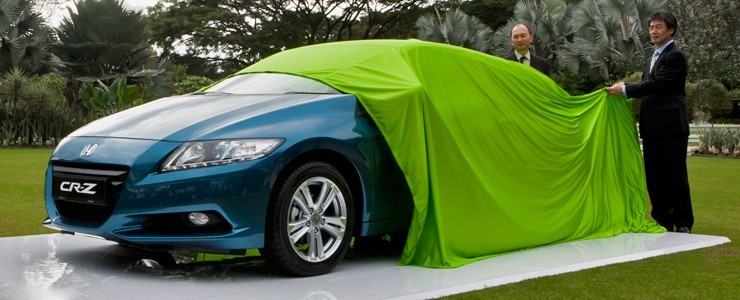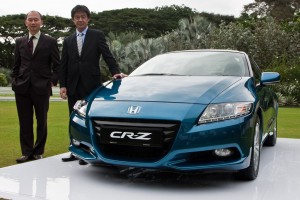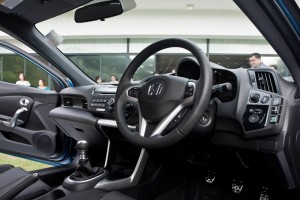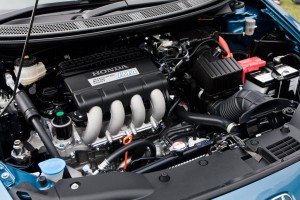Honda CR-Z makes its official debut in Singapore
01 Dec 2011|7,654 views
 As befits its green credentials, the CR-Z launch was held amidst the greenery of HortPark. The event was graced by the presence of the Large Project Leader for the CR-Z, Mr Norio Tomobe, who explained the CR-Z’s development and fielded questions from journalists about the car.
As befits its green credentials, the CR-Z launch was held amidst the greenery of HortPark. The event was graced by the presence of the Large Project Leader for the CR-Z, Mr Norio Tomobe, who explained the CR-Z’s development and fielded questions from journalists about the car.“The new Honda CR-Z continues Honda’s sporty heritage. It is a unique sports hybrid coupe with a new sense of adventure towards environmental responsibility,” says Mr Nicholas Wong, General Manager of Kah Motor. “Besides being stylish and fun to drive, the CR-Z impresses with its efficiency and economy.”
Exterior
 The CR-Z was created from a project to create a sporty coupe for the second decade of the 21st century. The compact dimensions, light weight construction and aerodynamic design bring a dual benefit of improving performance, but also cutting fuel consumption and emissions.
The CR-Z was created from a project to create a sporty coupe for the second decade of the 21st century. The compact dimensions, light weight construction and aerodynamic design bring a dual benefit of improving performance, but also cutting fuel consumption and emissions.The wide and low stance is enhanced at the front end by the unusual one piece grille, which extends above and below the front bumper line. This grille is a key feature of the car’s “face”, with a pronounced raised area of the bonnet flowing from its top line right up to the base of the windscreen. The wide tapering headlights, with day time running lights elegantly integrated into the lower edges, extend towards the edges of the strongly flared wheels arches.
The angle of curvature at the edge of the windscreen of the CR-Z is the greatest of any current Honda model, and it blends almost seamlessly into the A-pillars and side windows. This wraparound effect is only possible because of the revolutionary rain gutters integrated into the front pillars that significantly reduce the usual step between the edge of the windscreen and the A-pillar by 50%. As well as creating a distinctive visual effect, the reduction in this step has clear aerodynamic benefits, reducing turbulence in this important area. The integrated look is accentuated by the gloss black surface finish applied to the A-pillars, creating the illusion of a single piece of glass.
The wraparound screen positions the A-pillars further back in the side profile, giving the bonnet a longer and lower appearance. By curving the glass around the sides of the car, Honda’s engineers were able to achieve excellent forward visibility, a key factor in safety and enthusiastic driving.
Interior
 The cabin of the CR-Z has been designed around a cockpit theme, clustering critical controls close to the driver, creating a sense of purpose and reducing distractions. The upper dashboard section contains all of the controls and dials and is formed from a RIM (Reaction Injection Moulding) moulded black plastic, which has never been used for a Honda dashboard before. This new plastic material gives a pleasing, tactile to the upper dash surfaces.
The cabin of the CR-Z has been designed around a cockpit theme, clustering critical controls close to the driver, creating a sense of purpose and reducing distractions. The upper dashboard section contains all of the controls and dials and is formed from a RIM (Reaction Injection Moulding) moulded black plastic, which has never been used for a Honda dashboard before. This new plastic material gives a pleasing, tactile to the upper dash surfaces.The lower section of the dashboard is formed from a light-grey material, which gives the upper section the appearance of floating. The lower, lighter section is continued almost seamlessly into the doors, to wrap the cabin around the driver and passenger. The doors feature two major areas of colour, with the larger portion matching the texture and colour of the upper “floating” section and a middle swathe coordinating with the lower, light grey section. The door grabs have been treated with a special metallic coating, which is being used for the first time in an automotive interior application. This high-gloss film is coated with evaporated metal to create a unique texture for upper grade cars.
The seats have been designed to support the driver in enthusiastic driving, with particular attention paid to the angle of the seat in relation to the pedals. The angle was set to allow the driver to sit low in the car and maintain a comfortable and practical driving position. To complement the reach and rake adjustable steering wheel, the driver’s seat has a 50 mm range of height settings, with driver and passenger seats having a 240 mm range of front to back motion.
Under the Hood
 The CR-Z is the first car to combine a 1.5-litre i-VTEC engine and the IMA system, giving excellent fuel economy and great emphasis on driver enjoyment. This 112bhp engine is combined with a 13bhp electric motor which also boosts torque, with an impressive 78 Nm at low to medium engine speeds. The combined power figure peaks at 122bhp with a healthy 174 Nm of torque.
The CR-Z is the first car to combine a 1.5-litre i-VTEC engine and the IMA system, giving excellent fuel economy and great emphasis on driver enjoyment. This 112bhp engine is combined with a 13bhp electric motor which also boosts torque, with an impressive 78 Nm at low to medium engine speeds. The combined power figure peaks at 122bhp with a healthy 174 Nm of torque.Performance and driver enjoyment can be seen as a conflicting need to good fuel economy and exhaust emissions levels. The CR-Z’s 1.5-litre, 16-valve, i-VTEC, petrol engine provides driver enjoyment with its enthusiastic engine note, willingness to rev and broad spread of torque. At the same time its modest capacity, boosted by an electric motor can achieve excellent fuel economy and low overall exhaust emissions, including the all-important CO2 emissions. The CR-Z is the first Honda hybrid, since the original 1-litre Insight to use a four valve per cylinder head with the IMA system.
Honda’s engineers have developed the 3-Mode Drive System for the CR-Z, which allows the driver to alter the characteristics of the car depending on their needs and the environment the car is being driven in. By significantly altering the responses of the car, the CR-Z’s new system allows drivers to adapt to different road and traffic situations.
The 3-Mode System alters the behaviour of the hybrid drivetrain and the power steering assistance as well as the throttle mapping between the three modes. SPORT Mode sharpens the throttle response, changes the behaviour of the IMA hybrid system to provide more electric motor assistance and increases the weight of the electric power steering.
At all times the car can be run in NORMAL mode, which provides a balance between performance, economy and emissions and suits most driving situations, while ECON mode reduces the sensitivity of the throttle to smooth out inputs and this action is assisted by the use of a different engine map that prioritises fuel economy. The climate control system is also influenced by the ECON mode, by recirculating air and reducing compressor operation in order to reduce energy consumption. The use of the motor to assist the petrol engine is redefined with the priority given to improve fuel economy, not assist performance.
Technical Specifications
Honda CR-Z Hybrid 1.5 (M)
Engine
Type: SOHC i-VTEC 4-cylinder engine with Integrated Motor Assist
Displacement: 1,497cc
Max Power (bhp): 122 @ 6,100 rpm
Max Torque (Nm): 174 @ 1,000 - 1,500 rpm
(Both figures are for engine and electric motor combined)
Dimensions
Length (mm): 4,080
Width (mm): 1,740
Height (mm): 1,395
Wheelbase (mm): 2,435
As befits its green credentials, the CR-Z launch was held amidst the greenery of HortPark. The event was graced by the presence of the Large Project Leader for the CR-Z, Mr Norio Tomobe, who explained the CR-Z’s development and fielded questions from journalists about the car.
“The new Honda CR-Z continues Honda’s sporty heritage. It is a unique sports hybrid coupe with a new sense of adventure towards environmental responsibility,” says Mr Nicholas Wong, General Manager of Kah Motor. “Besides being stylish and fun to drive, the CR-Z impresses with its efficiency and economy.”
Exterior
The CR-Z was created from a project to create a sporty coupe for the second decade of the 21st century. The compact dimensions, light weight construction and aerodynamic design bring a dual benefit of improving performance, but also cutting fuel consumption and emissions.
The wide and low stance is enhanced at the front end by the unusual one piece grille, which extends above and below the front bumper line. This grille is a key feature of the car’s “face”, with a pronounced raised area of the bonnet flowing from its top line right up to the base of the windscreen. The wide tapering headlights, with day time running lights elegantly integrated into the lower edges, extend towards the edges of the strongly flared wheels arches.
The angle of curvature at the edge of the windscreen of the CR-Z is the greatest of any current Honda model, and it blends almost seamlessly into the A-pillars and side windows. This wraparound effect is only possible because of the revolutionary rain gutters integrated into the front pillars that significantly reduce the usual step between the edge of the windscreen and the A-pillar by 50%. As well as creating a distinctive visual effect, the reduction in this step has clear aerodynamic benefits, reducing turbulence in this important area. The integrated look is accentuated by the gloss black surface finish applied to the A-pillars, creating the illusion of a single piece of glass.
The wraparound screen positions the A-pillars further back in the side profile, giving the bonnet a longer and lower appearance. By curving the glass around the sides of the car, Honda’s engineers were able to achieve excellent forward visibility, a key factor in safety and enthusiastic driving.
Interior
The cabin of the CR-Z has been designed around a cockpit theme, clustering critical controls close to the driver, creating a sense of purpose and reducing distractions. The upper dashboard section contains all of the controls and dials and is formed from a RIM (Reaction Injection Moulding) moulded black plastic, which has never been used for a Honda dashboard before. This new plastic material gives a pleasing, tactile to the upper dash surfaces.
The lower section of the dashboard is formed from a light-grey material, which gives the upper section the appearance of floating. The lower, lighter section is continued almost seamlessly into the doors, to wrap the cabin around the driver and passenger. The doors feature two major areas of colour, with the larger portion matching the texture and colour of the upper “floating” section and a middle swathe coordinating with the lower, light grey section. The door grabs have been treated with a special metallic coating, which is being used for the first time in an automotive interior application. This high-gloss film is coated with evaporated metal to create a unique texture for upper grade cars.
The seats have been designed to support the driver in enthusiastic driving, with particular attention paid to the angle of the seat in relation to the pedals. The angle was set to allow the driver to sit low in the car and maintain a comfortable and practical driving position. To complement the reach and rake adjustable steering wheel, the driver’s seat has a 50 mm range of height settings, with driver and passenger seats having a 240 mm range of front to back motion.
Under the Hood
The CR-Z is the first car to combine a 1.5-litre i-VTEC engine and the IMA system, giving excellent fuel economy and great emphasis on driver enjoyment. This 112bhp engine is combined with a 13bhp electric motor which also boosts torque, with an impressive 78 Nm at low to medium engine speeds. The combined power figure peaks at 122bhp with a healthy 174 Nm of torque.
Performance and driver enjoyment can be seen as a conflicting need to good fuel economy and exhaust emissions levels. The CR-Z’s 1.5-litre, 16-valve, i-VTEC, petrol engine provides driver enjoyment with its enthusiastic engine note, willingness to rev and broad spread of torque. At the same time its modest capacity, boosted by an electric motor can achieve excellent fuel economy and low overall exhaust emissions, including the all-important CO2 emissions. The CR-Z is the first Honda hybrid, since the original 1-litre Insight to use a four valve per cylinder head with the IMA system.
Honda’s engineers have developed the 3-Mode Drive System for the CR-Z, which allows the driver to alter the characteristics of the car depending on their needs and the environment the car is being driven in. By significantly altering the responses of the car, the CR-Z’s new system allows drivers to adapt to different road and traffic situations.
The 3-Mode System alters the behaviour of the hybrid drivetrain and the power steering assistance as well as the throttle mapping between the three modes. SPORT Mode sharpens the throttle response, changes the behaviour of the IMA hybrid system to provide more electric motor assistance and increases the weight of the electric power steering.
At all times the car can be run in NORMAL mode, which provides a balance between performance, economy and emissions and suits most driving situations, while ECON mode reduces the sensitivity of the throttle to smooth out inputs and this action is assisted by the use of a different engine map that prioritises fuel economy. The climate control system is also influenced by the ECON mode, by recirculating air and reducing compressor operation in order to reduce energy consumption. The use of the motor to assist the petrol engine is redefined with the priority given to improve fuel economy, not assist performance.
Technical Specifications
Honda CR-Z Hybrid 1.5 (M)
Engine
Type: SOHC i-VTEC 4-cylinder engine with Integrated Motor Assist
Displacement: 1,497cc
Max Power (bhp): 122 @ 6,100 rpm
Max Torque (Nm): 174 @ 1,000 - 1,500 rpm
(Both figures are for engine and electric motor combined)
“The new Honda CR-Z continues Honda’s sporty heritage. It is a unique sports hybrid coupe with a new sense of adventure towards environmental responsibility,” says Mr Nicholas Wong, General Manager of Kah Motor. “Besides being stylish and fun to drive, the CR-Z impresses with its efficiency and economy.”
Exterior
The CR-Z was created from a project to create a sporty coupe for the second decade of the 21st century. The compact dimensions, light weight construction and aerodynamic design bring a dual benefit of improving performance, but also cutting fuel consumption and emissions.
The wide and low stance is enhanced at the front end by the unusual one piece grille, which extends above and below the front bumper line. This grille is a key feature of the car’s “face”, with a pronounced raised area of the bonnet flowing from its top line right up to the base of the windscreen. The wide tapering headlights, with day time running lights elegantly integrated into the lower edges, extend towards the edges of the strongly flared wheels arches.
The angle of curvature at the edge of the windscreen of the CR-Z is the greatest of any current Honda model, and it blends almost seamlessly into the A-pillars and side windows. This wraparound effect is only possible because of the revolutionary rain gutters integrated into the front pillars that significantly reduce the usual step between the edge of the windscreen and the A-pillar by 50%. As well as creating a distinctive visual effect, the reduction in this step has clear aerodynamic benefits, reducing turbulence in this important area. The integrated look is accentuated by the gloss black surface finish applied to the A-pillars, creating the illusion of a single piece of glass.
The wraparound screen positions the A-pillars further back in the side profile, giving the bonnet a longer and lower appearance. By curving the glass around the sides of the car, Honda’s engineers were able to achieve excellent forward visibility, a key factor in safety and enthusiastic driving.
Interior
The cabin of the CR-Z has been designed around a cockpit theme, clustering critical controls close to the driver, creating a sense of purpose and reducing distractions. The upper dashboard section contains all of the controls and dials and is formed from a RIM (Reaction Injection Moulding) moulded black plastic, which has never been used for a Honda dashboard before. This new plastic material gives a pleasing, tactile to the upper dash surfaces.
The lower section of the dashboard is formed from a light-grey material, which gives the upper section the appearance of floating. The lower, lighter section is continued almost seamlessly into the doors, to wrap the cabin around the driver and passenger. The doors feature two major areas of colour, with the larger portion matching the texture and colour of the upper “floating” section and a middle swathe coordinating with the lower, light grey section. The door grabs have been treated with a special metallic coating, which is being used for the first time in an automotive interior application. This high-gloss film is coated with evaporated metal to create a unique texture for upper grade cars.
The seats have been designed to support the driver in enthusiastic driving, with particular attention paid to the angle of the seat in relation to the pedals. The angle was set to allow the driver to sit low in the car and maintain a comfortable and practical driving position. To complement the reach and rake adjustable steering wheel, the driver’s seat has a 50 mm range of height settings, with driver and passenger seats having a 240 mm range of front to back motion.
Under the Hood
The CR-Z is the first car to combine a 1.5-litre i-VTEC engine and the IMA system, giving excellent fuel economy and great emphasis on driver enjoyment. This 112bhp engine is combined with a 13bhp electric motor which also boosts torque, with an impressive 78 Nm at low to medium engine speeds. The combined power figure peaks at 122bhp with a healthy 174 Nm of torque.
Performance and driver enjoyment can be seen as a conflicting need to good fuel economy and exhaust emissions levels. The CR-Z’s 1.5-litre, 16-valve, i-VTEC, petrol engine provides driver enjoyment with its enthusiastic engine note, willingness to rev and broad spread of torque. At the same time its modest capacity, boosted by an electric motor can achieve excellent fuel economy and low overall exhaust emissions, including the all-important CO2 emissions. The CR-Z is the first Honda hybrid, since the original 1-litre Insight to use a four valve per cylinder head with the IMA system.
Honda’s engineers have developed the 3-Mode Drive System for the CR-Z, which allows the driver to alter the characteristics of the car depending on their needs and the environment the car is being driven in. By significantly altering the responses of the car, the CR-Z’s new system allows drivers to adapt to different road and traffic situations.
The 3-Mode System alters the behaviour of the hybrid drivetrain and the power steering assistance as well as the throttle mapping between the three modes. SPORT Mode sharpens the throttle response, changes the behaviour of the IMA hybrid system to provide more electric motor assistance and increases the weight of the electric power steering.
At all times the car can be run in NORMAL mode, which provides a balance between performance, economy and emissions and suits most driving situations, while ECON mode reduces the sensitivity of the throttle to smooth out inputs and this action is assisted by the use of a different engine map that prioritises fuel economy. The climate control system is also influenced by the ECON mode, by recirculating air and reducing compressor operation in order to reduce energy consumption. The use of the motor to assist the petrol engine is redefined with the priority given to improve fuel economy, not assist performance.
Technical Specifications
Honda CR-Z Hybrid 1.5 (M)
Engine
Type: SOHC i-VTEC 4-cylinder engine with Integrated Motor Assist
Displacement: 1,497cc
Max Power (bhp): 122 @ 6,100 rpm
Max Torque (Nm): 174 @ 1,000 - 1,500 rpm
(Both figures are for engine and electric motor combined)
Dimensions
Length (mm): 4,080
Width (mm): 1,740
Height (mm): 1,395
Wheelbase (mm): 2,435
Latest COE Prices
October 2025 | 2nd BIDDING
NEXT TENDER: 05 Nov 2025
CAT A$122,000
CAT B$131,889
CAT C$76,801
CAT E$136,000
View Full Results Thank You For Your Subscription.




































